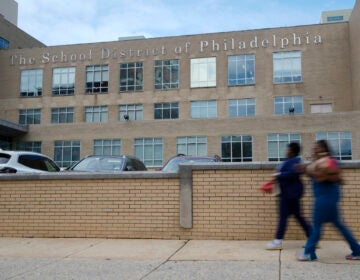Report: Don’t expand charters without examining consequences

(Wavebreak Media Ltd/BigStock)
Large urban school districts such as Philadelphia should account for how charter growth might harm traditional district schools when granting new charters, according to a report released Wednesday.
The left-leaning Economic Policy Institute paper examined 11 school districts — including Philadelphia — that experienced dramatic charter growth since 2000.
It recommends districts take a more holistic approach when approving charter schools. Instead of simply considering academic outcomes, the report said, districts should examine how new schools might alter a city’s education landscape.
“If we consider a specific geographic space, like a major urban center, operating under the reality of finite available resources (local, state, and federal revenues), the goal is to provide the best possible system for all children citywide, given the resources available,” wrote Bruce Baker, the Rutgers University professor who authored the report. “That is, resources should be used most efficiently and equitably to achieve the best possible system of schools for all children.”
The study, however, failed to substantiate a central critique of the charter movement, namely that charter growth handcuffs traditional school districts because it saps them of resources and forces them to use remaining money inefficiently.
For years, charter skeptics have claimed that charters harm traditional public schools by draining them of students and resources, ultimately creating a system of winners and losers.
To that point, many believe charters create “stranded costs.”
The theory goes like this: When a student leaves a traditional public school for a charter, the district no longer must pay the direct costs of educating that child. However, the district still must pay heating bills, maintenance costs, administrative salaries, and all sorts of other expenses associated with the the school that the student left behind. Baker’s report cites several studies that have documented these stranded costs
“District budgets don’t simply reduce by the loss of a student. There are layers of different types of costs within any institutional structure,” said Baker. “So you’re retaining some of those expenses even though you’re losing a trickle of students over time “
Curiously, however, Baker didn’t find any evidence of this phenomenon in his latest study. In fact he uncovered some data that suggest the opposite.
Baker’s research found that traditional school districts manage to keep overhead, administrative costs, school size, and teacher-student ratios fairly constant — even as those districts lose thousands of students to new charters. In Philadelphia, for instance, about 5 percent of students attend a school that is “inefficiently small.” That figure has remained constant for more than a decade.
The same goes for overhead costs. In 2000, Philadelphia spent about 22 percent of its revenue on administration, plant operations, and transportation. By 2012, those non-classroom expenses only accounted for 20.1 percent of all spending, despite a large migration of students to charter schools.
Essentially, when big districts such as Philadelphia lose students they manage to consolidate services and overhead expenses in a way that allows them to run with similar efficiency.
“I found for the most part that the districts I was looking at on those particular issues adjusted reasonably,” said Baker.
Baker examined federal data in order to make apples-to-apples comparisons across cities, and he said those particular data sets weren’t targeted enough to capture stranded costs.
“I agree there’s not a lot in that data to tease out the inefficiencies,” he said.
Baker does, however, still believe that charter expansion creates redundancies, and he points to other studies that have relied on more precise, local data to make that argument.
Academic outcomes overlooked, charter proponents say
That argument doesn’t sit well with charter advocates.
“The whole report was written through the lens of how does this affect school districts, as if the whole purpose of education is the health of school districts,” said Greg Richmond, head of the National Association of Charter School Authorizers.
Richmond argued any evaluation of charter schools should assess student performance.
“You can’t even have a conversation about financial efficiency unless it’s in relation to academic outcomes,” he said.
Baker, however, believes a hyper-focus on academic measures blinds school districts to the larger consequences of charter expansion. Such an approach, he said, ignores how opening new charters might ripple through the rest of the education ecosystem in a city and leave certain children stranded in underfunded buildings.
“People have reduced the whole charter school debate to — is there an average test score difference, an average test score gain? And if one set of schools does better than the other, then we should simply expand that set of schools,” Baker said.
His report, titled “Exploring the consequences of charter school expansion in U.S. cities,” arrives amid renewed debate over charter schools.
Betsy DeVos, President-elect Donald Trump’s pick for to lead the U.S. Department of Education, is a staunch advocate of charters and school vouchers. During his campaign, Trump floated the idea of redirecting $20 billion in federal aid to expand school choice.
Teachers unions and other political allies of traditional public school systems believe such policies will lead to the privatization of education and fuel inequity.
As the rhetoric heightens on both sides, reports such as Baker’s are fertile ground for partisan bickering.
“This is a political piece,” said Richmond. “This is a political agenda in search of anecdotes.”
Regardless of one’s ideological allegiance, Baker’s work contains some interesting insights on Philadelphia’s school system during the charter boom of the past 15 years.
Between 2000 and 2012, Philadelphia students attending charters climbed from 4 percent to 27.7 percent. During that same time, total enrollment in public and charter schools combined fell from 213,000 to 191,000 — a drop of about 10 percent.
Baker also calculated the district’s revenue in inflation-adjusted dollars between 2000 and 2013, and found an increase from $1.497 billion to $1.674 billion.
Despite that relative stability, the Rutgers professor dubbed Philadelphia “the least well-funded of the nation’s high-poverty, large urban districts, even though the poverty rate of the students it serves is more than double that of surrounding districts.”
WHYY is your source for fact-based, in-depth journalism and information. As a nonprofit organization, we rely on financial support from readers like you. Please give today.





